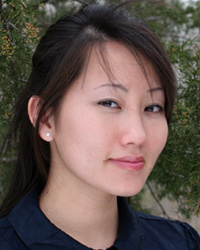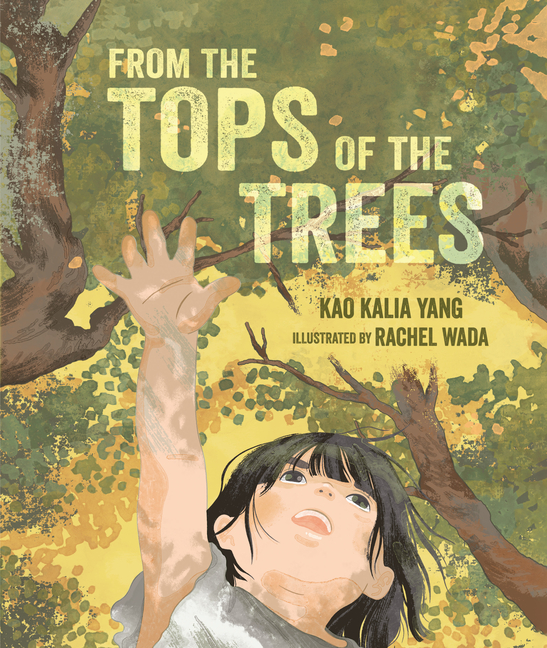From Teaching to Writing

TeachingBooks asks each author or illustrator to reflect on their journey from teaching to writing. Enjoy the following from Kao Kalia Yang.
I learned how to teach before I knew I could write. I was twelve at the time. There was a group of older Vietnamese women in the Mount Airy Housing Project. There was a summer program connecting elders with young people. They were looking for a young person, someone to work with the elders on simple English. I was a selective mute in the English language, a girl who missed her grandmother in California terribly because I lived in Minnesota with my family and we couldn’t afford to call her long distance, or to visit. I was full of despair about my unrequited love for a Thai actor in Thailand who had no idea of my existence. The program administrator stood in front of our homeroom class waiting for some sign of interest. I surprised myself when my left hand went up timidly. I was given a flyer with a location and time and told the women would be waiting.
My father had dropped me off. The palms of my hands itched with nervousness. In front of the classroom door, I wiped my palms against the rough fabric of my jeans again and again. I quietly opened the door. I poked my head inside.
Slowly that day and all the others, we learned how to navigate the uncomfortable terrain of learning a new language, a common language, a way to be kind and useful to each other.
There were about nine women in the room. They were all old like my grandmother. Some of them had her short curly hair, white strands pulled back and tied with rubber bands. They sat around two banquet tables talking to each other loudly. I saw the arthritic hands on the table holding bundles of mail. They wanted me to help them go through their mail. I knew this before I entered.
Once I stepped into the room, the things I thought I knew dissipated in the air. The ticking of the clock on the white wall of the community center grew loud. The women looked me up and down, this short young thing, nodding in greeting, clearing her throat again and again to bring some noise into the suddenly quiet space. I waved. I waved to each and every single woman. They, in turn, waved back. I wrote my name on the board, not the one people in school called me but the one my family did: Kalia. I whispered it. They whispered it after me.
Without my knowing, I had established a mood for my very first classroom, an atmosphere of silence, of regard, of quiet observation. Slowly that day and all the others, we learned how to navigate the uncomfortable terrain of learning a new language, a common language, a way to be kind and useful to each other. I gave them markers. We marked up their piles of mail. We made checkmarks on the important stuff, the bills, the letters from governmental agencies, and big X’s on all the rest. We smiled and nodded our approval of each other. When we were confused, we saw it first in each other’s gaze. We learned how to communicate slowly, and painstakingly we started taking steps to caring for each other.
I let their interests lead our time together; we arrived in places we hadn’t known existed and we marveled.
By summer’s end, the same twelve year old girl in the beginning had become something else: a fuller version of herself. I wrote things on the board. I drew things. They laughed. They shook their heads. They wrote checkmarks by the things that spoke to them and big X’s on the rest. They showed me what was interesting to them. I let their interests lead our time together; we arrived in places we hadn’t known existed and we marveled. We taught each other the beauty of a successful classroom: the astounding power of arriving at a place together.
Years and years later, many different classrooms since, I still think of the women in the classroom, the different cultures and languages we came from, and the bit of magic that we discovered in our shared commitment to showing up for each other. It is what I do on the page when I’m at my best: I allow myself to enter into spaces and situations that push me, make me uncomfortable, that necessitate that I become a different, more comfortable version of myself to navigate, and I adventure where my interests and that of my characters lead me. The heart of this writer and teacher are the same; I am still that girl, uncertain within, trying to bridge a world without, to show up in the places where others may not be so interested, to gather what I can of life from the wisdom that surrounds us.
Through teaching, I learned of myself as a writer.
Books and Resources

TeachingBooks personalizes connections to books and authors. Enjoy the following on Kao Kalia Yang and the books she’s created.
Listen to Kao Kalia Yang talking with TeachingBooks about the backstory for writing From the Tops of the Trees. You can click the player below or experience the recording on TeachingBooks, where you can read along as you listen, and also translate the text to another language.
- Listen to Kao Kalia Yang talk about her name
- Watch Kao Kalia Yang discuss the true story behind From the Tops of the Trees
- Discover Kao Kalia Yang’s page and books on TeachingBooks
- Visit Kao Kalia Yang on her website, Facebook, Twitter, and Instagram.
Explore all of the For Teachers, By Teachers blog posts.
Special thanks to Kao Kalia Yang and Lerner for their support of this post. All text and images are courtesy of Kao Kalia Yang and Lerner, and may not be used without expressed written consent.



First of all, I love your name. From the Tops of the Trees; how expressive. Wonderful story. I’m very glad that you shared this with the world.
“We taught each other the beauty of a successful classroom: the astounding power of arriving at a place together”
So well said. To open ones eyes and hearts to a world unknown is a joyous thing to share. Keep Writing!